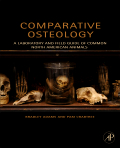Zoomify Images: Fig 14-02b Hornless sheep cranium/dentition
Fig 14-02b (A) Polled (hornless) sheep cranium (lateral view, right side). Sheep and goat are closely related species, and fragmentary remains of the two taxa can be diffi cult to distinguish. Boessneck and colleagues (Boessneck 1969; Boessneck, et al. 1964) present the most comprehensive guide to the osteological distinctions that are evident on the postcranial skeleton. Since the publication of Boessneck’s work, researchers have attempted to identify distinguishing features of the dentition of sheep and goats. Payne (1985) identifi es several distinctions that can be seen on the deciduous dentition, while Halstead and Collins (2002) identify differences on the mandibles and mandibular teeth of adult sheep and goats. Zeder and Pilaar (2010) assess the reliability of the criteria used to distinguish mandibles and mandibular teeth, while Zeder and Lapham (2010) assess the reliability of the postcranial criteria. (B) Polled sheep cranium (ventral view). The sheep’s third molars have not erupted but are visible in the crypts.
Download Slide

